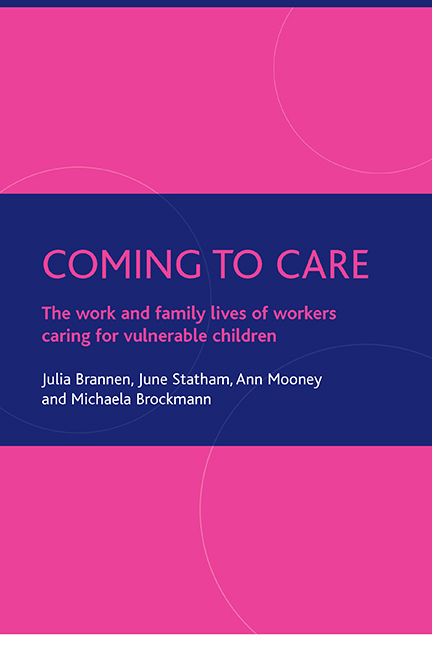Book contents
- Frontmatter
- Contents
- List of tables and boxes
- Acknowledgements
- one Setting the scene
- two The study
- three The origins of a care ethic in care workers’ childhoods
- four Entering care work with vulnerable children
- five Care workers’ careers and identities: change and continuity
- six What do vulnerable children need? Understandings of care
- seven Experiences of care work
- eight Leavers, movers and stayers
- nine Managing care work and family life
- ten Conclusions and policy implications
- Appendix: Boxes and additional tables
- References
- Index
ten - Conclusions and policy implications
Published online by Cambridge University Press: 15 September 2022
- Frontmatter
- Contents
- List of tables and boxes
- Acknowledgements
- one Setting the scene
- two The study
- three The origins of a care ethic in care workers’ childhoods
- four Entering care work with vulnerable children
- five Care workers’ careers and identities: change and continuity
- six What do vulnerable children need? Understandings of care
- seven Experiences of care work
- eight Leavers, movers and stayers
- nine Managing care work and family life
- ten Conclusions and policy implications
- Appendix: Boxes and additional tables
- References
- Index
Summary
Main conclusions from the study
The study sought to examine four particular groups of childcare workers. The four groups have in common that they care for some of the most disadvantaged children in society. The children's situations are on a continuum of disadvantage and include children of different ages (young children to young adults) with different levels of need.
The study is unusual in having adopted a time perspective in its multi-phase, multi-method research design and in its use of a biographical perspective. In the book we have stressed how accounts of motivations and explanations for doing care work with vulnerable young people are given in the present. They are thus framed in relation to the interests of the study and how the study was presented to informants – what they thought we as researchers were interested in. Stories and interview accounts are also framed through the lens of hindsight in the context of events that took place in the past and to which a range of meanings have subsequently been attached. Thus, present explanations are offered by individuals in the knowledge of the persons they have become and the experiences they have currently. They are framed too in the context of how they think about the future: their plans, hopes and dreams.
In its focus on the past the study sought to understand care workers’ past lives: how the inclination to care for others developed, their pathways into childcare work and caring for vulnerable children in particular. It also focused upon their current experiences: the ways in which childcare workers interpreted the nature of the work they do and the resources and knowledge bases they drew upon and their experiences of the different work contexts and work conditions. It also took a future perspective in terms of looking at care workers’ expectations of their futures in childcare work and through its prospective design examined how far intentions matched practices, the reasons why care workers stayed or left the work and what they went on to do. The study therefore fills a significant gap in our understanding of care workers’ lives over time, through its focus upon childcare workers’ biographies and in its prospective design.
- Type
- Chapter
- Information
- Coming to CareThe Work and Family Lives of Workers Caring for Vulnerable Children, pp. 205 - 222Publisher: Bristol University PressPrint publication year: 2007



